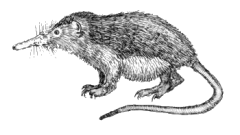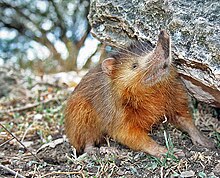Solenodon
| Solenodon[1] | |
|---|---|

| |
| Cuban Solenodon (Solenodon cubanus) | |
| Scientific classification | |
| Kingdom: | |
| Phylum: | |
| Class: | |
| Order: | |
| Family: | Solenodontidae Gill, 1872
|
| Genus: | Solenodon Brandt, 1833
|
| Type species | |
| Solenodon paradoxus Brandt, 1833
| |
| Species | |
|
†Solenodon arredondoi | |
Solenodons (meaning "slotted-tooth") are venomous, nocturnal, burrowing, insectivorous mammals belonging to the family Solenodontidae. Only one genus, Solenodon, is known, although a few other genera were erected at one time and are now regarded as junior synonyms. Solenodontidae is interesting to phylogenetics researchers because of its retention of primitive mammal characteristics; their species resemble very closely those that lived near the end of the age of the dinosaurs. They are one of two families of Caribbean soricomorphs; it is uncertain whether the other family, Nesophontidae, which went extinct during the Holocene, was closely related to solenodons.[2]
The two living solenodon species are the Cuban Solenodon (Solenodon cubanus), and the Haitian or Hispaniolan Solenodon (Solenodon paradoxus). Two other species went extinct during the Quaternary. Oligocene North American genera such as Apternodus have been suggested as relatives of Solenodon, but the origins of the animal remain obscure.[2]
Characteristics
Solenodons resemble very large shrews, and are often compared to them; with extremely elongated cartilaginous snouts, long, naked, scaly tails, small eyes, and coarse, dark brown to black hair. The snout is flexible, and in the Hispaniola Solenodon, actually has a ball-and-socket joint at the base to increase its mobility. This allows the animal to investigate narrow crevices where potential prey may be hiding. Between 28–32 centimetres (11–13 inches) long from nose to rump, and weighing between 700–1,000 grams (25–35 oz),[4] solenodons are known to become very easily agitated and may squeal or bite with little or no provocation.
Solenodons have a few intriguing traits, two of them being the position of the two teats on the female, almost on the buttocks of the animal, and the second being the venomous saliva that flows from modified salivary glands in the mandible through grooves on the second lower incisors ("solenodon" derives from the Greek "grooved tooth"). Solenodons are among a handful of venomous mammals.
The diet of solenodons consists largely of insects, earthworms, and other invertebrates, but they also eat vertebrate carrion, and perhaps even some living vertebrate prey such as small reptiles or amphibians.[4] Solenodons have a relatively unspecialised, and almost complete, dentition, with a dental formula of: 3.1.3.33.1.3.3.
Solenodons give birth in a nesting burrow, to one or two young. The young remain with the mother for several months, and initially follow the mother about by hanging onto her elongated teats. Once they reach adulthood, solenodons are solitary animals, who rarely interact except to breed.[4]
Status


Both species became endangered species because of predation by the Small Asian Mongoose (specifically subspecies Herpestes javanicus auropunctatus), which was introduced in colonial times to hunt snakes and rats, as well as by feral cats and dogs. The Hispaniolan Solenodon is practically extinct, with sightings of specimens or their spoor occurring rather infrequently. The Cuban Solenodon was thought to have been extinct until a live specimen was found in 2003. Marcano's Solenodon (Solenodon marcanoi) went extinct in the Holocene.
References
- ^ Hutterer, R. (2005). "Order Soricomorpha". In Wilson, D.E.; Reeder, D.M (eds.). Mammal Species of the World: A Taxonomic and Geographic Reference (3rd ed.). Johns Hopkins University Press. pp. 222–223. ISBN 978-0-8018-8221-0. OCLC 62265494.
- ^ a b c Whidden, H. P.; Asher, R. J. (2001), "The origin of the Greater Antillean insectivorans", in Woods, C. A.; Sergile, F. E. (eds.), Biogeography of the West Indies: Patterns and Perspectives, Boca Raton, London, New York, and Washington, D.C.: CRC Press, pp. 237–252, ISBN 0-8493-2001-1
- ^ Savage, RJG, & Long, MR (1986). Mammal Evolution: an illustrated guide. New York: Facts on File. p. 51. ISBN 0-8160-1194-X.
{{cite book}}: CS1 maint: multiple names: authors list (link) - ^ a b c Nicoll, Martin (1984). Macdonald, D. (ed.). The Encyclopedia of Mammals. New York: Facts on File. pp. 748–749. ISBN 0-87196-871-1.
External links
- The Last Survivors Project [1] Updated news on Caribbean Mammals Conservation Project
- Entry at Animal Diversity Web
- Morelle, Rebecca (2009-01-09), Venomous mammal caught on camera (video), BBC News, retrieved 2010-05-31
- Scent of a solenodon: On the trail of a living fossil (video), BBC News, 2010-05-30, retrieved 2010-05-30
- EDGE of Existence "(Cuban solenodon)" Saving the World's most Evolutionarily Distinct and Globally Endangered (EDGE) species
- EDGE of Existence "(Hispaniolan solenodon)" Saving the World's most Evolutionarily Distinct and Globally Endangered (EDGE) species
- BBC News 1 June 2010 The cave of bones: A story of solenodon survival
- BBC News 2 June 2010 Close encounter with a bizarre venomous beast
